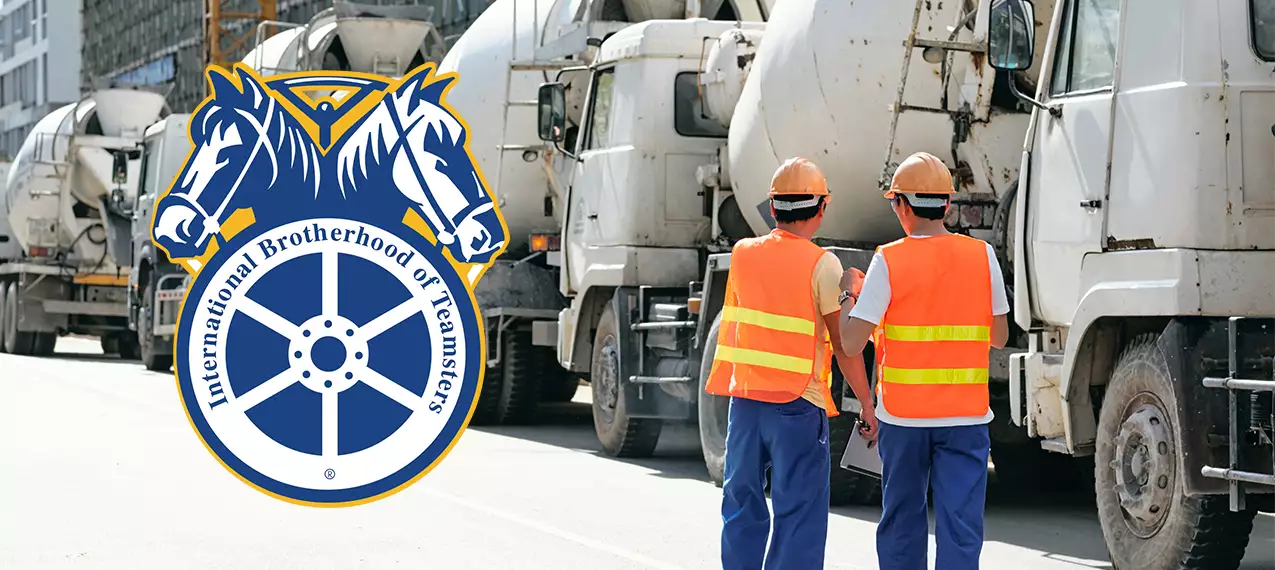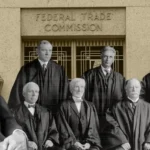
SUMMARY
On November 8, Landmark filed a merits brief in support of the petitioner in Glacier NW, Inc. v. International Brotherhood of Teamsters Local Union 174, that called on the U.S. Supreme Court to overrule the Washington Supreme Court and protect property rights. Landmark filed at the cert stage this summer as well, successfully urging the U.S. Supreme Court to take the case.
The issue in this case was whether intentional destruction of the employer’s property during a strike was protected by the federal National Labor Relations Act. The union waited until the company’s cement trucks were fully loaded for delivery and then called for a work stoppage. This was intentionally timed to destroy the company’s property by leaving the concrete to harden in the trucks’ mixing drums. The Washington Supreme Court ruled that incidental destruction of company property during a strike is protected by the federal National Labor Relations Act, preventing the company from recovering damages in a state case. Under the Constitution’s Supremacy Clause, federal statutes take precedence over conflicting state statutes and preempt them. But Congress usually must make it clear that state law is being preempted by federal statutes.
The ruling below disregards decades of precedent and centuries of common law regarding the right to collect damages for intentional property destruction. It also heavily incentivizes the use of violence and destruction by unions during strikes- something that the National Labor Relations Act was passed to prevent.
This is a critical labor relations case and Landmark urges the U.S. Supreme Court to reverse this lower court ruling and restore the balance of power between employers and unions.
Read the brief.
DEEP DIVE
On January 10th, 2023, the Supreme Court will hear oral arguments in Glacier NW, Inc. v. International Brotherhood of Teamsters Local Union 174 (“Glacier”)
The Court will consider whether the intentional destruction of an employer’s property during a strike was protected by the National Labor Relations Act (“NLRA”). On August 11, 2017, a Teamsters union waited to begin a work stoppage until their employer’s cement trucks were fully loaded for delivery. The union intentionally timed this strike to destroy their employer’s property by leaving the concrete to harden in the trucks’ mixing drums.
The employer sought to recover damages in the Washington state courts, where they argued their claims over four arduous years of litigation. In December 2021, the Washington Supreme Court ruled that incidental destruction of company property during a strike is protected by the NLRA, preventing the company from recovering damages. The company appealed this decision to the U.S. Supreme Court.
The Washington Supreme Court’s ruling disregards decades of precedent and centuries of common law establishing the right to collect damages for intentional property destruction. Allowing this ruling to stand incentivizes the use of violence and destruction by unions during labor negotiations – something that the NLRA was explicitly passed to prevent. In our amicus brief for this case, Landmark urged the U.S. Supreme Court to reverse this lower court ruling and restore the balance of power between employers and unions.
Glacier carries serious implications for the future of property rights and American labor relations. To comprehend the ramifications of this case – and the importance of Landmark’s advocacy for the employer – it is important to understand the historical context of the laws and institutions at play.
The Birth of the National Labor Relations Board
During the early 20th Century, the United States endured a period of serious labor unrest.
In 1922, for instance, the Railway Shopcraft strike involved over “1,500 cases of violent assault to kill, 51 cases of dynamiting and burning railroad bridges, 65 reported kidnappings, [and] many other incidents of destruction.” Around this time, in West Virginia, striking coal miners, local law enforcement and National Guard personnel waged the “Battle of Blair Mountain” – a veritable shooting war resulting in up to 100 deaths. The Colorado Coalfield Wars of the mid-1910s led to similarly massive casualties, after employers ignored the demands of laborers who turned to violence to advance their negotiations.
In response to this widespread violence – which threatened to paralyze the industrial economy – Congress implemented a series of measure to level the playing field of collective bargaining between labor and management. The cornerstone of this legislation was the NLRA (also known as the Wagner Act) passed in 1935 as part of the New Deal.
The Wagner Act recognized that “the failure to recognize the right to unionize or engage in collective bargaining will lead to strikes and other forms of industrial strife or unrest.” Under the statute, unions were given the right to strike and engage in collective bargaining. Concerted activities (the technical term for union endeavors such as strikes) were officially protected by the federal government. The statute also declared that employers were prohibited from engaging in an array of “unfair labor practices.”
To enforce these provisions, the NLRA created a special panel (known as the National Labor Relations Board (“NLRB”)) to address complaints of wrongdoing against unions. By providing a venue outside the courts, where unions could expect a fair shake and swift resolutions, the NLRB was intended to “obviate appeals to brute force which are too often the accompaniment of labor disputes.”[1] Indeed, the NLRB has endured over the past 87 years as a sympathetic venue for maligned union workers and as a source of expertise in handling complex labor questions.
Following World War II, Congress amended the NLRA with the Labor-Management Relations Act (“LMRA”), also known as the Taft-Hartley Act. Taft-Hartley proscribed unfair labor practices committed by unions themselves. Taft-Hartley also extended business the statutory right to bring NLRB complaints against improper behavior by their union employees. This amendment “recognize[d] under law that neither party has any right in its relations with any other to engage in acts or practices which jeopardize the public health, safety, or interest.” It did not establish, however, any clear test for when employers may bring these complaints into court, rather than the NLRB.
The Courts, The Board, and The Emergence of Garmon Preemption
The NLRB was not an ideal venue for instances when property damage occurred during a labor dispute. Early on, the U.S. Supreme Court observed in United Workers v. Laburnum Corp. (1954) that the NLRB possesses no “general compensatory” remedy. Indeed, the Board’s statutory powers extend only to worker-specific remedies – such as ordering the reinstatement of employees or the payment of back wages.[2] Because the NLRB cannot award compensatory damages, constitutional conceptions of property rights dictate that injured parties to a labor dispute can seek those damages in the state courts.[3]
During the mid-20th century, at times unions sought federal protection for outlandishly dangerous and destructive activities.[4] The courts routinely found unions liable for the damages. Limiting companies’ options for obtaining recourse to only the NLRB would have resulted in countless millions of unrecovered damages.
Despite these pitfalls, there were legal arguments for deferring to the NLRB even when a union’s concerted activities caused noticeable damage to an employer’s property. For example, it is often difficult to discern exactly where financial harm (ex. lost profits during a strike) transcends the protected economic battles waged between unions and employers. The NLRB’s expertise outweighs that of the courts in deciding the extent of whether conduct constitutes an unfair labor practice. Thus, according to the NLRB’s proponents, this expertise was sufficient grounds for broadly deferring to the Board, so that courts may not inappropriately tread into federal territory.[5]
These various doctrines came to a head in the landmark Supreme Court opinion Garmon v. San Diego Bldg. Trades Council (1959). This decision, written by the erstwhile labor advocate Justice Felix Frankfurter, broadly expanded the extent of union activity protected from state intervention. Garmon prohibited a San Diego lumber yard owner from seeking damages against a union which had peacefully picketed around his property, causing him to lose customers. By blocking the lumber yard’s action, the Court established an expansive approach to the NLRA’s preeminence over state law. The majority declared that the NLRB’s jurisdiction preempts state courts whenever conduct in a labor dispute is even “arguably” protected or prohibited under the Wagner Act or Taft-Hartley.
Taken at face value, this rule would almost universally restrict the use of state forums to settle disputes arising from labor activity. Such an understanding of the preemption power would cast an illogically large penumbra. There is nothing in either the Wagner Act or Taft-Hartley to suggest that state courts are barred from hearing tortious or criminal cases arising from a labor dispute. Indeed, Garmon preemption could be one of those instances in which a federal statute was used improperly by the courts to justify implied preemption of state regulation.[6] As one Harvard law professor recently observed, “It would be difficult to find a regime of federal preemption broader than the one grounded in the National Labor Relations Act.”[7]
A Local Interest in Preventing Violence and Destruction
The Frankfurter Court seemed to recognize some limits to its preemption umbrella. Garmon distinguished two exceptions to the NLRB’s preeminence over state courts on issues of “arguable” labor conduct. The first, also known as a Machinist’s Exception, said that the NLRA did not have authority over issues of “merely peripheral concern” to national labor policy.[8] The second exception, known as the Local Interest Exception, held that the NLRB could not preempt state courts “where the regulated conduct touched interests so deeply rooted in local feeling and responsibility that, in the absence of compelling congressional direction, we could not infer that Congress had deprived the States of the power to act.”[9]
Justice Frankfurter’s wording suggests that, unlike the states’ new labor regulations, historical state criminal laws and common law tort systems would not be displaced.
Indeed, the cases cited in defense of the local interest exception upheld a principle that the states alone can provide for the consequences of violence and destruction of property. Among these cases was United Auto. Workers v. Wisconsin Emp. Rel. Bd., an opinion which upheld an injunction against a violent picket line. In this ruling, the Court emphasized that:
“The States are the natural guardians of the public against violence. It is the local communities that suffer most from the fear and loss occasioned by coercion and destruction. We would not interpret an act of Congress to leave them powerless to avert such emergencies without compelling directions to that effect.”[10]
The chief power possessed by the states to guard the public against “coercion and destruction” is their courts’ ability to penalize people engaging in tortious or criminal activities. As Garmon’s Local Interest Exception showed, the NLRB was never intended to unilaterally remove these historical state court guardrails. Even the legal scholar Archibald Cox, one of the most famous proponents of broad preemption power, acknowledged that “Congress developed [the NLRB] within a larger context of state law creating rights of property, bodily security, and personality, preserving public order, and promoting public health and welfare.”[11]
By erasing these state protections, for instance by refusing to apply a Local Interest Exception when appropriate, courts would incentivize violent and destructive activity. The NLRB has no means to provide punitive or remedial damages for a tort claim.[12] Thus, if a union knows it will never have to face an injured employer recovering damages in court, they can use destruction as leverage during labor negotiations. Without the Local Interest Exception keeping state courts involved, the balance of power would be decisively in labor’s favor as they would effectively be immunized from punishment for such improper activity.[13]
A Peaceable Posterity
The Court cannot endorse the principle asserted in Glacier by the Washington Supreme Court. If the holding below survives, the United States may once again witness an era of violent labor unrest.
Evidence suggests that strikes will become more commonplace in the future. During the past 10 months, there have already been over 316 strikes – at least a 20% increase from the total for all of 2021. A looming recession will probably result in further casualties in the labor market, as foreboded by the 10,000 Amazon employees set to be laid off before the holiday retail rush.
No doubt, workers have a protected right to advocate for their interests. This is especially so when they face a desperate economic backdrop. Even so, it is imperative that their complaints are channeled into a peaceful process.
Several notably destructive labor protests have recently occurred. Even when they involved some protected activities, the courts have tended to award damages for the most destructive of these incidents, including in cases quite similar to Glacier.[14] Still, this deterrence could just as easily be overturned by a reckless interpretation of the Garmon local interest exception.
By overturning the Washington State Supreme Court’s dangerous precedent in Glacier, the Supreme Court will ensure that state courts will continue to function as an important bulwark for justice. A reversal in Glacier would ensure that unions are not immunized from destroying property just because they are unions. Taking this important step would promote more peaceful and economically prosperous labor relations for a generation.
[1] See: NLRB v. Del.-New Jersey Ferry Co., 90 F.2d 520, 520 (3d Cir. 1937).
[2] See: Republic Steel Corp. v. NLRB, 311 U.S. 7, 10 (1940).
[3] Perhaps it was even “because of this belief that [court] remedies were available [that the Taft-Hartley] Congress made no attempt to provide general compensation for the victims of tortious acts. The N.L.R.B. was given no general compensatory powers at all, and its injunctive powers are clearly not useable to compensate victims.” See: William J. Dunaj, Labor Law: The “Compelling State Interest” Exception to the Federal Preemption Doctrine, 51 Marq. L. Rev. 89, 91 (1967). See also: Cedar Point Nursery v. Hassid, 141 S. Ct. 2063, 2080 (2021) (Kavanaugh, J., concurring)
[4] See: U.S. Steel Co. (Joliet Coke Works) v. NLRB, 196 F.2d 459 (7th Cir. 1952), a case in which aggressive strikers actively risked the combustion and possible explosion of massive chemical stockpiles. NLRB v. Marshall Car Wheel & Foundry Co., 218 F.2d 409, 411 (5th Cir. 1955), a case in which it was “practically undisputed that the striking [foundry] employees intentionally chose a time for their walkout when molten iron in the plant cupola was ready to be poured off, and that a lack of sufficient help to carry out the critical pouring operation might well have resulted in substantial property damage and pecuniary loss to respondent.”
[5] See: U.S. Steel Co. v. NLRB, 196 F.2d 459 (7th Cir. 1952).
[6] See: Wyeth v. Levine, 555 U.S. 555, 583 (2009) (Thomas, J., concurring).
[7] See: Benjamin I. Sachs, Despite Preemption: Making Labor Law in Cities and States, 124 Harv. L. Rev. 1153, 1154 (March 2011).
[8] See: International Ass’n of Machinists v. Gonzales, 356 U.S. 617 (1958).
[9] See: San Diego Bldg. Trades Council v. Garmon, 359 U.S. 236, 244 (1959) (emphasis added).
[10] See: United Auto. Workers v. Wisconsin Emp. Rel. Bd., 351 U.S. 266, 274-275 (1956).
[11] See: Archibald Cox, Labor Law Preemption Revisited, 85 Harv. L. Rev. 1337, 1355-56 (1972).
[12] See: Virginia Elec. & Power Co, v. NLRB, 319 U.S. 533, 543 (1943).
[13] In Laburnum, the Court assumed that the union engaged in an unfair labor practice but noted how the NLRB’s procedures would not provide adequate remedies. Preempting the state court “will, in effect, grant petitioners immunity from liability for their tortious conduct” and there was “no substantial reason for reaching such a result” 347 U.S. at 664.
[14] See: Rockford Redi-Mix, Inc. v. Teamsters Loc. 325, Gen. Chauffeurs, Helpers & Sales Drivers of Rockford, 551 N.E.2d 1333 (Ill. App. Ct. 1990), a case in which striking Teamsters pulled the same stunt as the employees in Glacier. Whereas Glacier was graced with a heroic effort to save the trucks, in Redi-Mix the “cement had hardened in the trucks, and an attempt to rotate the drums resulted in blowing the hydraulic lines.” In that case, the court upheld the award of damages.
SUPPORT LANDMARK LEGAL FOUNDATION
We are truly facing existential threats to our individual rights and liberties, the Constitution, and our national character. If unchallenged, this assault on our very way of life will ruin our great nation. With your financial and moral support, Landmark is not going to let that happen without a fight. Will you join us?





